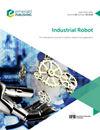A humanoid robot teleoperation approach based on waist-arm coordination
IF 2.5
4区 计算机科学
Q3 ENGINEERING, INDUSTRIAL
Industrial Robot-The International Journal of Robotics Research and Application
Pub Date : 2023-04-20
DOI:10.1108/ir-12-2022-0306
引用次数: 1
Abstract
Purpose In the current teleoperation system of humanoid robots, the control between arms and the control between the waist and arms are individual and lack coordinated motion. This paper aims to solve the above problem and proposes a teleoperation control approach for a humanoid robot based on waist–arm coordination (WAC). Design/methodology/approach The teleoperation approach based on WAC comprises dual-arm coordination (DAC) and WAC. The DAC method realizes the coordinated motion of both arms through one hand by establishing a mapping relationship between a single hand controller and the manipulated object; the WAC method realizes the coordinated motion of both arms and waist by calculating the inverse kinematic input of robotic arms based on the desired velocity of the waist and the end of both arms. An integrated teleoperation control framework provides interfaces for the above methods, and users can switch control modes online to adapt to different tasks. Findings After conducting experiments on the dual-arm humanoid robot through the teleoperation control framework, it was found that the DAC method can save 27.2% of the operation time and reduce 99.9% of the posture change of the manipulated object compared with the commonly used individual control. The WAC method can accomplish a task that cannot be done by individual control. The experiments proved the improvement of both methods in terms of operation efficiency, operation stability and operation capability compared with individual control. Originality/value The DAC method better maintains the constraints of both arms and the manipulated object. The WAC method better maintains the constraints of the manipulated object itself. Meanwhile, the teleoperation framework integrates the proposed methods and enriches the teleoperation modes and control means.一种基于腰臂协调的仿人机器人遥操作方法
目的在目前的仿人机器人遥操作系统中,手臂之间的控制和腰臂之间的控制是个体的,缺乏运动的协调性。本文针对上述问题,提出了一种基于腰臂协调的仿人机器人遥操作控制方法。基于WAC的远程操作方法包括双臂协调(DAC)和WAC。DAC方法通过建立单手控制器与被控对象之间的映射关系,通过一只手实现双臂的协调运动;WAC方法通过计算机器人手臂的逆运动学输入,以腰部和双臂末端的期望速度为基础,实现手臂和腰部的协调运动。集成的遥操作控制框架为上述方法提供了接口,用户可以在线切换控制模式以适应不同的任务。通过遥操作控制框架对双臂人形机器人进行实验,发现与常用的个体控制相比,DAC方法可节省27.2%的操作时间,减少被操纵对象的姿态变化99.9%。WAC方法可以完成单个控件无法完成的任务。实验证明,与个体控制相比,两种方法在运行效率、运行稳定性和运行能力方面都有提高。DAC方法更好地保持了手臂和被操纵对象的约束。WAC方法更好地维护了被操纵对象本身的约束。同时,远程操作框架整合了上述方法,丰富了远程操作模式和控制手段。
本文章由计算机程序翻译,如有差异,请以英文原文为准。
求助全文
约1分钟内获得全文
求助全文
来源期刊
CiteScore
4.50
自引率
16.70%
发文量
86
审稿时长
5.7 months
期刊介绍:
Industrial Robot publishes peer reviewed research articles, technology reviews and specially commissioned case studies. Each issue includes high quality content covering all aspects of robotic technology, and reflecting the most interesting and strategically important research and development activities from around the world.
The journal’s policy of not publishing work that has only been tested in simulation means that only the very best and most practical research articles are included. This ensures that the material that is published has real relevance and value for commercial manufacturing and research organizations. Industrial Robot''s coverage includes, but is not restricted to:
Automatic assembly
Flexible manufacturing
Programming optimisation
Simulation and offline programming
Service robots
Autonomous robots
Swarm intelligence
Humanoid robots
Prosthetics and exoskeletons
Machine intelligence
Military robots
Underwater and aerial robots
Cooperative robots
Flexible grippers and tactile sensing
Robot vision
Teleoperation
Mobile robots
Search and rescue robots
Robot welding
Collision avoidance
Robotic machining
Surgical robots
Call for Papers 2020
AI for Autonomous Unmanned Systems
Agricultural Robot
Brain-Computer Interfaces for Human-Robot Interaction
Cooperative Robots
Robots for Environmental Monitoring
Rehabilitation Robots
Wearable Robotics/Exoskeletons.

 求助内容:
求助内容: 应助结果提醒方式:
应助结果提醒方式:


